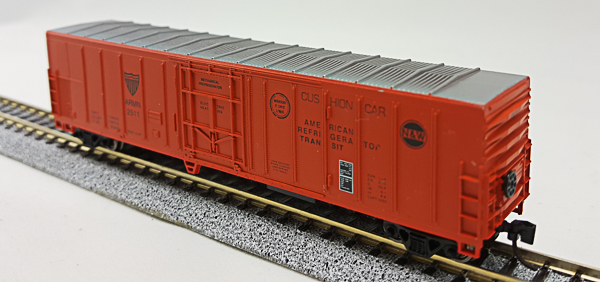Prototype History:
One of the greatest freight car innovations of the 20th century was the creation of the refrigerator car, commonly referred to as a “reefer.” The ability to haul perishables such as fruits, vegetables and meat products across the country was a major factor in the development of modern America. No longer did food have to be produced close enough to urban areas, so that it could be consumed before spoiling. At the same time, areas with additional capacity for agricultural production could produce more food, since it did not have to be sold locally.
For many years, reefers relied on ice bunkers to keep loads cool. After World War II, technological advances made mechanical refrigeration practical for a freight car. In addition, a mechanical reefer could be larger than an ice reefer because of the greater cooling capabilities.
Fruit Growers Express owned the largest fleet of reefers in the East. FGE was owned by a group of ten railroads, with Atlantic Coast Line and Southern being two of the largest original owners. Many of FGE cars were built at its Jacksonville Shops, including these 57’ smooth-side mechanical reefers.
For many years, reefers relied on ice bunkers to keep loads cool. After World War II, technological advances made mechanical refrigeration practical for a freight car. In addition, a mechanical reefer could be larger than an ice reefer because of the greater cooling capabilities.
Fruit Growers Express owned the largest fleet of reefers in the East. FGE was owned by a group of ten railroads, with Atlantic Coast Line and Southern being two of the largest original owners. Many of FGE cars were built at its Jacksonville Shops, including these 57’ smooth-side mechanical reefers.
Road Name History:  The American Refrigerator Transit Company (ART) was a St. Louis, Missouri-based private refrigerator car line established in 1881 by the Missouri Pacific and Wabash railroads. It is now a subsidiary of the Union Pacific Corporation.
The American Refrigerator Transit Company (ART) was a St. Louis, Missouri-based private refrigerator car line established in 1881 by the Missouri Pacific and Wabash railroads. It is now a subsidiary of the Union Pacific Corporation.

Brand/Importer Information: Con-Cor has been in business since 1962. Many things have changed over time as originally they were a complete manufacturing operation in the USA and at one time had upwards of 45 employees. They not only designed the models,but they also built their own molds, did injection molding, painting, printing and packaging on their models.
Currently, most of their manufacturing has been moved overseas and now they import 90% of their products as totally finished goods, or in finished components. They only do some incidental manufacturing today within the USA.
Important Note: The Con-Cor product numbering can be very confusing. Please see here in the article how to properly enter Con-Cor stock numbers in the TroveStar database.
Currently, most of their manufacturing has been moved overseas and now they import 90% of their products as totally finished goods, or in finished components. They only do some incidental manufacturing today within the USA.
Important Note: The Con-Cor product numbering can be very confusing. Please see here in the article how to properly enter Con-Cor stock numbers in the TroveStar database.
Item created by: CNW400 on 2019-01-08 11:51:58. Last edited by CNW400 on 2020-05-15 09:36:46
If you see errors or missing data in this entry, please feel free to log in and edit it. Anyone with a Gmail account can log in instantly.
If you see errors or missing data in this entry, please feel free to log in and edit it. Anyone with a Gmail account can log in instantly.










